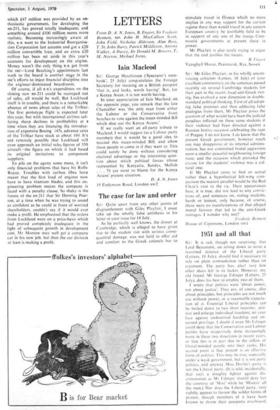Rough Ride
JOHN BULL
There is a lot more noise coming out of Rolls-Royce these days than just the ticking of clocks. It's still just as impressive as ever to own one of their cars but it's a different question with their shares. After last week's annual meeting they fell to not very far off the year's low of lOs 41d, and a long drive away from the heady days of 1968 when they stood at 55s.
In 1968, Rolls-Royce's profits were £15.9 million, but they fell sharply to a mere
£6.4 million last year. and chairman Sir Denning Pearson—in the same week that his £9,000 salary increase took effect—
warned shareholders that there was little sign that this downWard trend would change until 1972 or even 1973.
To make matters worse, the R-R board can't even forecast how bad the profit plunge
is likely to be. Things change very quickly in a year of massive inflation and the com- pany is currently beset by three separate problems: a major union clash with its white collar workers who want the present wage structure rationalised, doubts over big orders, and the fact that its biggest customer.
Lockheed, is itself in financial trouble. Each of these problems is grave, and put together they make a pretty potent triumvirate for the new company 'doctor', Ian Morrow, to contend with.
- Two years ago, Rolls-Royce seemed set for a great national and commercial suc- cess. In the face of intense competition from the American General Electric com- pany, it won the contract to build the RR-21 to power the Lockheed TriStar airbus. There was confident talk -about aero engine orders of around £I.000 million by 1980, in the world's toughest market. However, it may make good engines and lovely cars, but a-s can't manage its financial problems too well. The original estimate of £70 million, of
which £47 million was provided by an en- thusiastic government, for developing the
an-211, has proved totally inadequate; and something around £100 million-seems more realistic. Becoming increasingly aware of this, it-it went to the Industrial Reorganisa- tion Corporation last autumn and got a £20 million convertible loan, and an extra £20 million has been set aside in this year's accounts for development on the engine. Money wasn't the only thing R-R got from the tac—Lord Beeching's appointment last week to the board is another stage in the IRC'S efforts to inject financial discipline into the engineer-dominated boardroom.
Of course, if all R-R's expenditure on the shining new an-211 could be recouped out of sales, all would be well. But Lockheed itself is in trouble, and there is a remarkable absence of news about sales of the TriStar. The first prototype flight is expected later this year, but with international airlines suf- fering sharp declines in profitability at a time when they are financing the introduc- tion of expensive Boeing /47s, advance sales of the TriStar have stuck at about 180. It's not remotely possible that Lockheed will even approach an initial sales figures of 350 aircraft—the figure on which it had based its original invitations to component
suppliers. .
To pile on the agony some more, it isn't only financial problems that have hit Rolls- Royce. Troubles with carbon fibre have meant that the first load of engines now have to have titanium blades, and this en- gineering problem means the company is faced with a penalty clause. So shaky is the future of the an-211 that Sir Denning Pear- son, at a time when he was trying to sound as confident as he could in front of worried shareholders, couldn't say if it would ever make a profit. He emphasised that the orders from Lockheed were on a price-basis which had proved completely inadequate in the light of subsequent growth in development cost. Mr Morrow may well get a company car in his new job, but then the car division at least is making a profit.
ffolkes's investors' alphabet
B is for Bear market































 Previous page
Previous page